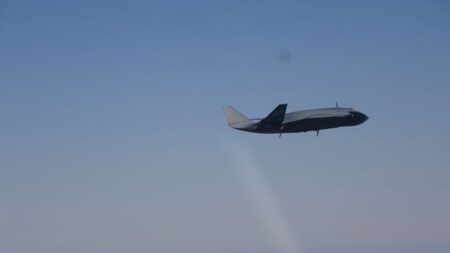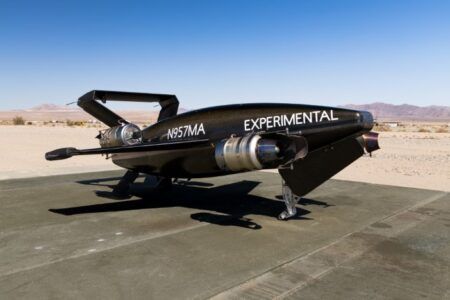Caption: Time-lapse image of the EagleRay transitioning from underwater to the air. Image credit: Matthew Bryant
Engineers at North Carolina State University have developed the world’s first unmanned drone capable of traveling through the air and underwater.
The EagleRay drone can transition repeatedly between sky and sea. Researchers hope one day it could be used to track wildlife. The drone can also perform underwater monitoring such as taking sonar readings across multiple locations, as well as moving sensors around underwater.
The project, which started in 2014 and is funded by US aerospace and defense firm, Teledyne, has so far conducted 12 cross-domain missions, including some under autonomous operation. Several tests have been carried out to characterize and illustrate each stage of operation including surface locomotion, underwater locomotion, water egress, flight, and water ingress
The current prototype of EagleRay has a wingspan of 5ft (1.5m) and is 4.6ft (1.4m) long, weighing in at 12.6 lb (5.7kg). It has a dual-use propeller, powered by an electric motor, that propels it through both air and water.
Key subsystems of EagleRay include a passively flooding and draining wing, a single motor and propeller combination for propulsion in both domains, and aerodynamic-hydrodynamic control surfaces.
Warren Weisler, a researcher on the project, said, “Maintaining aerial surveillance can use a lot of energy. The EagleRay can conserve energy by spending some of its time in the water. For example, it could track a fast-moving pod of dolphins from the air, then spend time loitering in the water if the dolphins stop to take advantage of a good feeding spot. The EagleRay could then resume flight when the dolphins begin moving again.”
“We’re currently developing a custom controller for the EagleRay,” Weisler said. “Existing controllers aren’t designed for a vehicle that transitions from air to sea and back again – they’re designed to be one or the other, with no transition stage.”
The researchers are also refining a dynamic model of the EagleRay for use in simulations that can be used for training purposes, to predict performance under various conditions and to refine the vehicle design.
Matthew Bryant, assistant professor at NC State’s Department of Mechanical and Aerospace Engineering, said “A key point regarding the EagleRay design is that it is scalable – you can make larger or smaller models as needed.
“It really depends on the size of the desired payload, how long you’d need it to operate, and so on.”
The paper, Testing and Characterization of a Fixed Wing Cross-Domain Unmanned Vehicle Operating in Aerial and Underwater Environments, is published in the IEEE Journal of Oceanic Engineering. Weisler is lead author of the paper. Co-authors include Stewart, Bryant, Peters, Gopalarathnam and Mark Anderson of Teledyne.
19 February 2018




